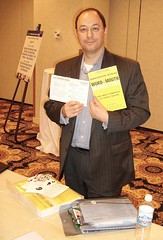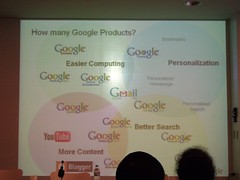This morning am at Harvard’s Cyber|West conference, which is running concurrently with the Cyberposium. Keynote was by Google’s Marissa Mayer, talking about Google’s strategy. Many of her points tied to the same points that Eric Schmidt made at Web 2.0 earlier this week, and echoed the theme that “although Google’s process appears chaotic, our strategy is not.” Their strategy ties to four main points:
- More Content
- Easier Computing
- Personalization
- Better Search
More on these below.
“More Content”
- The web is important, and indexing books is also important. Books are (usually) vetted, fact-checked. “Google Book Search is “our moon shot.”
- In 10 years, all digital information online and searchable
- Google is developing page-turning robots that turn pages, take photos, then do OCR (optical character recognition) of the words on the page, which can then be indexed.
- Google Earth is also an example of “more content.” Satellite image + user-tagged locations are important, and a melding of Google-created content and user created content.
- Branching out more and more about more types of information
“Easier Computing”
- If easier to use computers, people will use google more
- Muni wifi…when people have free access, they use the internet more
- “What’s good for the web is good for google”
- “Google Pack” – google toolbar, desktop, picasa, google earth, etc., and bundle them into a single download, three clicks to set up
- Google docs and spreadsheets … “easier to create documents and spreadsheets”
“Personalization”
- “Implicit search”…bring interesting content without asking for it
- Personalized homepage … make it your own
- Gadgets, API to create, able to syndicate (can add to own homepage)
- Google notebook … research tool
- Custom search engine
Why are we doing all these things?
Common theme ties all the issues initiatives together…”although our efforts look chaotic, they all tie to the four key themes in our strategy”
Q&A
Q: There are a lot of opportunities around social networking…but outside Orkut, there doesn’t seem to be a lot going on
A: Our social networking efforts have been well-recieved, and we’re the social network of choice in a particular geography (e.g. Brazil and India for Orkut). If you look at YouTube and Google Video, they are social networking sites. Content creation and socialization go hand-in-hand. When we look at these applications (GV, docs, spreadsheets, etc.), we make it easy to share them with your contacts, AND publish to the world if you choose to. We have intrinsic social networking coming in more products. “Content creation is a social act.”
Q: Why don’t all the products all work together?
A: We develop in parallel, see what works, then integrate over time.
Q: How is Google advertising different?
A: We have several hundred thousand advertisers. With text-based ads, we lowered the cost of production (instead of a graphic production house to spend several weeks). We also increased the relevance.
Q: What aspect of the business model is tied to others building tools on Google’s tools, and allow developers to use Google as a platform?
A: Gadgets–we do have the ability for companies to use us as a distribution platform. Google Web Toolkit…takes Java, turns to it Javascript to run inside the browser?
Q: Strategy on going local? How do you turn online search to offline purchase?
A: We have been looking at how we can reach out to various small merchants. 1) Local business Center, where businesses can provide hours, location, delivery region, etc. We also learned that a lot of small businesses don’t have web pages, but have click-to-call, which allows the offline business to facilitate contact with businesses that might not have websites.
Q: What are you doing with podcasting?
A: Doing a lot of work in speech-to-text in research, to enable automated indexing of podcasts.
Q: Personalization…does it mean the end of privacy?
A: The amount of privacy that as user needs can be decided by them. We learned our lesson with the privacy firestorm around Gmail. It’s important to adhere to policy transparency around all our products, to tell people what we know about them. For example, you can click and see your search history. We try to be very transparent about how the matching happens between email text and the ads.
Other points…
“There’s no such thing as a ‘success failure’ on the internet…that is, there’s no case where an offering is so successful that it crashes down. once something has great success, we can find a way to monetize it, through advertising, through subscriptions, through other models.
She also spoke about “Extreme Ironing.”




 In a nutshell: Economics, economies and economic theory have all been based on economics of scarcity. That is, scarcity drives the “laws” of economics. A number of things have hit the radar over the last few months that are of note:
In a nutshell: Economics, economies and economic theory have all been based on economics of scarcity. That is, scarcity drives the “laws” of economics. A number of things have hit the radar over the last few months that are of note:



